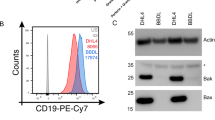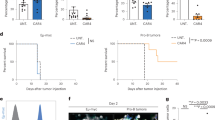Abstract
Objectives
IRX-2 is a novel immunotherapeutic containing physiologic quantities of several cytokines which protects human T lymphocytes from tumor-induced or drug-induced apoptosis. Here, we investigate the mechanisms responsible for IRX-2-mediated protection of T lymphocytes exposed to tumor-derived microvesicles (TMV).
Methods
Jurkat cells or primary human T cells ± IRX-2 were co-incubated with TMV and then examined by flow cytometry or Western blots for expression of molecules regulating cell survival (FLIP, Bcl-2, Bcl-xL, Mcl-1) or death (Fas, caspase 8, caspase 9, Bax, Bid). ANX V binding, caspase activation or cytochrome c release were also measured ± cycloheximide (CHX) or ± the Akt-specific inhibitor. Jurkat cells transfected with the cFLIP gene were used to evaluate the role of cFLIP in IRX-2-mediated protection. Effects of CHX on IRX-2-mediated protection and activation of NF-κB upon the TMV/IRX-2 treatment were also measured.
Results
IRX-2 protected T cells from apoptosis by preventing Fas overexpression induced by TMV and blocking caspase 8 activation by up-regulating cFLIP. Jurkat cells overexpressing cFLIP were more resistant to TMV-induced apoptosis than the mock-transfected cells (p < 0.02). Signaling via the PI3K/Akt pathway, IRX-2 corrected the imbalance of pro- versus anti-apoptotic proteins induced by TMV and promoted NF-κB translocation to the nucleus. CHX abolished IRX-2-mediated protection in T cells, suggesting that IRX-2 induces de novo synthesis of one or more proteins that are required for protection.
Conclusions
This biologic may be therapeutically useful for protection of activated T cells from tumor-induced immune suppression and death.






Similar content being viewed by others
Abbreviations
- TMV:
-
Tumor-derived microvesicles
- ANXV:
-
Annexin V
- PBMC:
-
Peripheral blood mononuclear cells
- CHX:
-
Cycloheximide
- BSA:
-
Bovine serum albumin
- FBS:
-
Fetal bovine serum
- MMP:
-
Mitochondrial membrane potential
- AICD:
-
Activation-induced cell death
- CTL:
-
CD8+ cytotoxic T lymphocytes
- TCR:
-
T cell receptor
- FLIP:
-
Cellular caspase 8 (FLICE)-like inhibitory protein
References
Chaudhuri D, Suriano R, Mittelman A, Tiwari RK (2009) Targeting the immune system in cancer. Curr Pharm Biotechnol 10(2):166–184
Parmiani G, De Filippo A, Novellino L, Castelli C (2007) Unique human tumor antigens: immunobiology and use in clinical trials. J Immunol 178(4):1975–1979
Lee PP, Yee C, Savage PA et al (1999) Characterization of circulating T cells specific for tumor-associated antigens in melanoma patients. Nat Med 5(6):677–685
Romero P, Cerottini JC, Speiser DE (2006) The human T cell response to melanoma antigens. Adv Immunol 92:187–224
Whiteside TL (2010) Immune responses to malignancies. J Allergy Clin Immunol 125(2 Suppl 2):S272–S283
Zhang T, Herlyn D (2009) Combination of active specific immunotherapy or adoptive antibody or lymphocyte immunotherapy with chemotherapy in the treatment of cancer. Cancer Immunol Immunother 58(4):475–492
Hoffmann TK, Dworacki G, Tsukihiro T et al (2002) Spontaneous apoptosis of circulating T lymphocytes in patients with head and neck cancer and its clinical importance. Clin Cancer Res 8(8):2553–2562
Whiteside TL (2002) Tumor-induced death of immune cells: its mechanisms and consequences. Semin Cancer Biol 12(1):43–50
Abusamra AJ, Zhong Z, Zheng X et al (2005) Tumor exosomes expressing Fas ligand mediate CD8+ T-cell apoptosis. Blood Cells Mol Dis 35(2):169–173
Whiteside TL (2005) Tumour-derived exosomes or microvesicles: another mechanism of tumour escape from the host immune system? Br J Cancer 92(2):209–211
Bergmann C, Strauss L, Wieckowski E et al (2009) Tumor-derived microvesicles in sera of patients with head and neck cancer and their role in tumor progression. Head Neck 31(3):371–380
Huber V, Fais S, Iero M et al (2005) Human colorectal cancer cells induce T-cell death through release of proapoptotic microvesicles: role in immune escape. Gastroenterology 128(7):1796–1804
Kim JW, Wieckowski E, Taylor DD, Reichert TE, Watkins S, Whiteside TL (2005) Fas ligand-positive membranous vesicles isolated from sera of patients with oral cancer induce apoptosis of activated T lymphocytes. Clin Cancer Res 11(3):1010–1020
Taylor DD, Gercel-Taylor C, Lyons KS, Stanson J, Whiteside TL (2003) T-cell apoptosis and suppression of T-cell receptor/CD3-zeta by Fas ligand-containing membrane vesicles shed from ovarian tumors. Clin Cancer Res 9(14):5113–5119
Czystowska M, Han J, Szczepanski MJ et al (2009) IRX-2, a novel immunotherapeutic, protects human T cells from tumor-induced cell death. Cell Death Differ 16(5):708–718
Gastman BR, Atarshi Y, Reichert TE et al (1999) Fas ligand is expressed on human squamous cell carcinomas of the head and neck, and it promotes apoptosis of T lymphocytes. Cancer Res 59(20):5356–5364
Song G, Ouyang G, Bao S (2005) The activation of Akt/PKB signaling pathway and cell survival. J Cell Mol Med 9(1):59–71
Wieckowski EU, Visus C, Szajnik M, Szczepanski MJ, Storkus WJ, Whiteside TL (2009) Tumor-derived microvesicles promote regulatory T cell expansion and induce apoptosis in tumor-reactive activated CD8+ T lymphocytes. J Immunol 183(6):3720–3730
Thome M, Tschopp J (2001) Regulation of lymphocyte proliferation and death by FLIP. Nat Rev Immunol 1(1):50–58
Uriarte SM, Joshi-Barve S, Song Z et al (2005) Akt inhibition upregulates FasL, downregulates c-FLIPs and induces caspase-8-dependent cell death in Jurkat T lymphocytes. Cell Death Differ 12(3):233–242
Karin M, Lin A (2002) NF-kappaB at the crossroads of life and death. Nat Immunol 3(3):221–227
Kataoka T, Budd RC, Holler N et al (2000) The caspase-8 inhibitor FLIP promotes activation of NF-kappaB and Erk signaling pathways. Curr Biol 10(11):640–648
Gastman BR, Johnson DE, Whiteside TL, Rabinowich H (2000) Tumor-induced apoptosis of T lymphocytes: elucidation of intracellular apoptotic events. Blood 95(6):2015–2023
Kim JW, Tsukishiro T, Johnson JT, Whiteside TL (2004) Expression of pro- and antiapoptotic proteins in circulating CD8+ T cells of patients with squamous cell carcinoma of the head and neck. Clin Cancer Res 10(15):5101–5110
Cheng EH, Kirsch DG, Clem RJ et al (1997) Conversion of Bcl-2 to a Bax-like death effector by caspases. Science 278(5345):1966–1968
Danial NN (2007) BCL-2 family proteins: critical checkpoints of apoptotic cell death. Clin Cancer Res 13(24):7254–7263
Gupta S, Gollapudi S (2007) Susceptibility of naive and subsets of memory T cells to apoptosis via multiple signaling pathways. Autoimmun Rev 6(7):476–481
Ma A, Koka R, Burkett P (2006) Diverse functions of IL-2, IL-15, and IL-7 in lymphoid homeostasis. Annu Rev Immunol 24:657–679
Molto L, Rayman P, Paszkiewicz-Kozik E et al (2003) The Bcl-2 transgene protects T cells from renal cell carcinoma-mediated apoptosis. Clin Cancer Res 9(11):4060–4068
Weng C, Li Y, Xu D, Shi Y, Tang H (2005) Specific cleavage of Mcl-1 by caspase-3 in tumor necrosis factor-related apoptosis-inducing ligand (TRAIL)-induced apoptosis in Jurkat leukemia T cells. J Biol Chem 280(11):10491–10500
Budd RC, Yeh WC, Tschopp J (2006) cFLIP regulation of lymphocyte activation and development. Nat Rev Immunol 6(3):196–204
Krueger A, Schmitz I, Baumann S, Krammer PH, Kirchhoff S (2001) Cellular FLICE-inhibitory protein splice variants inhibit different steps of caspase-8 activation at the CD95 death-inducing signaling complex. J Biol Chem 276(23):20633–20640
Schmitz I, Krueger A, Baumann S, Schulze-Bergkamen H, Krammer PH, Kirchhoff S (2003) An IL-2-dependent switch between CD95 signaling pathways sensitizes primary human T cells toward CD95-mediated activation-induced cell death. J Immunol 171(6):2930–2936
Van Parijs L, Refaeli Y, Abbas AK, Baltimore D (1999) Autoimmunity as a consequence of retrovirus-mediated expression of C-FLIP in lymphocytes. Immunity 11(6):763–770
Acknowledgments
This study was supported in part by NIH grant PO1 CA109688 to TLW.
Conflict of interest
None of the authors have any conflict of interest.
Author information
Authors and Affiliations
Corresponding author
Electronic supplementary material
Below is the link to the electronic supplementary material.
Rights and permissions
About this article
Cite this article
Czystowska, M., Szczepanski, M.J., Szajnik, M. et al. Mechanisms of T-cell protection from death by IRX-2: a new immunotherapeutic. Cancer Immunol Immunother 60, 495–506 (2011). https://doi.org/10.1007/s00262-010-0951-9
Received:
Accepted:
Published:
Issue Date:
DOI: https://doi.org/10.1007/s00262-010-0951-9




